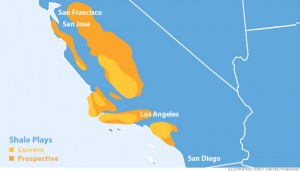
NEW YORK (CNNMoney)
California is sitting on a massive amount of shale oil and could become the next oil boom state. But only if the industry can get the stuff out of the ground without upsetting the state’s powerful environmental lobby.
Running from Los Angeles to San Francisco, California’s Monterey Shale is thought to contain more oil than North Dakota’s Bakken and Texas’s Eagle Ford — both scenes of an oil boom that’s created thousands of jobs and boosted U.S. oil production to the highest rate in over a decade.
n fact, the Monterey is thought to hold over 400 billion barrels of oil, selon l'U.S. Geological Survey. That’s nearly half the conventional oil in all of Saudi Arabia.
“Four hundred billion barrels, that doesn’t escape anyone in this businesses,” a déclaré Stephen Trammel, directeur de recherche de l'énergie à l'IHS Cambridge Energy Research Associates.
L'astuce est maintenant le sortir.
À la suite de la panne San Andres, Couches géologiques de la Californie sont repliés comme un accordéon plutôt que empilés simplement sur le dessus de l'autre comme ils sont dans d'autres Etats des schistes. Les plis ont naturellement fissuré la roche de schiste, et beaucoup de courant en Californie “conventionnel” la production de pétrole — le troisième plus grand dans la nation — est pensé pour provenir du Monterey.
Mais les plis signifient progrès récents qui ont fait de l'huile de schiste et de gaz rentable d'extraire — forage horizontal combiné avec la fracturation hydraulique — ne fonctionnent pas aussi bien en Californie. Il est difficile de percer horizontalement si le schiste n'est pas plat.
Plus, il semble que le Monterey est constitué de schiste qui ne répond pas aussi bien à la fracturation hydraulique — la pratique controversée appelée fracking qui implique l'injection d'eau, sable et de produits chimiques dans le sol sous haute pression pour fissurer la roche et permettent le pétrole et le gaz de circuler.
Toujours, la Americaines. Energy Information Agency estime qu'il ya plus de 15 milliard de barils de pétrole qui peuvent être récupérés en utilisant la technologie d'aujourd'hui.
“C'est un très grand nombre,” a déclaré Matt Woodson, un analyste du cabinet de recherche en énergie Wood Mackenzie. Woodson a déclaré que le 15 milliards nombre dépasse de loin les estimations actuelles pour le Dakota du Nord Bakken Shale, et environ la moitié du montant détenu dans le versant nord de l'Alaska avant qu'il a été exploité.
Ce potentiel a attiré l'attention de l'industrie pétrolière.
Several oil companies have put together research teams to work on the Monterey, said Katie Potter, head of exploration and production staffing at NES Global Talent, a company that recruits oil industry professionals.
If the Monterey takes off, Potter said the impact on jobs in the state would be huge, saying the shale boom has already created 600,000 jobs nationwide over the last few years.
“It could potentially solve the state’s budget deficit,” dit-elle.
Connexe: Etats-Unis. to become biggest oil producer — IEA
Mois dernier, the government held a lease sale to drill in the Monterey. While only a modest 18,000 acres were offered, they were all snapped up.
Occidental (OXY, Fortune 500), which is California-based and has long held acres in the Monterey, has had some success using a technology known as deep acid injection, said IHS’s Trammel.
The process involves injecting hydrofluoric or other acids deep underground, where they eat away at the shale rock and allow the oil to flow. It’s cheaper than fracking, said Trammel. And while it sounds ominous, it may not be as controversial, as the volumes involved are far less and it’s not done under such pressure, dit-il.
Toujours, no matter how the oil is produced, environmentalists in the Golden State are keeping close watch.
Fracking could still become an issue, as it has in other states where it’s led to fears over groundwater contamination, said Nathan Matthews, a Sierra Club attorney based in San Francisco. And there’s no guarantee acid injection is much better.
Plus, there’s air pollution, road congestion and other issues that go along with an oil boom.
Matthews wants California regulators to require full disclosure of everything the oil industry is putting in the ground, as well as individual permits issued for each well drilled.
“There’s a chance to get this done much better than where it’s been done elsewhere,” said Matthews. “We need to understand the risks before we open the flood gate.”
Regulations or not, there’s still no guarantee there will be an oil boom at all.
“It might not live up to its expectations,” said Fadel Gheit, a senior energy analyst at Oppenheimer. “The industry has not concluded whether it’s boom or bust.”
But given the rapid advances over the last few years in oil drilling and producing technology, the smart money may be on boom.
“There are some pretty creative people in this industry,” said Trammel. “Je dirais qu'ils vont comprendre.” Haut de page


Pas de commentaire
Commentaires pour Californie pourrait être le prochain état de boom pétrolier sont maintenant fermés.